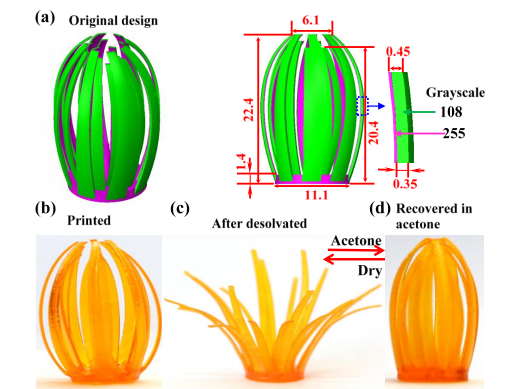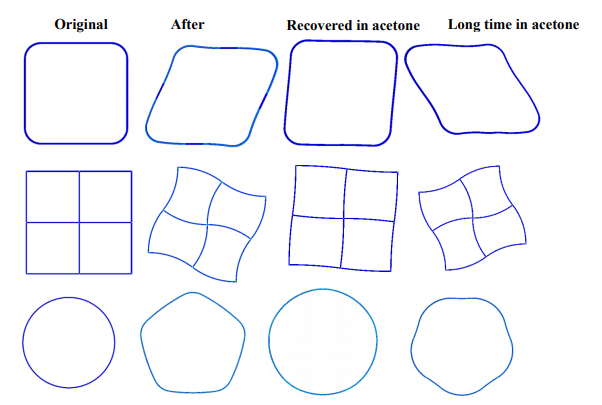Photopolymerization is a process that uses light to combine monomer molecules to create a polymer. It’s the basis of 3D printing, and in a dissertation called “Constitutive Modeling of Photopolymerization and its Application to 3D Printing,” Georgia Tech student Jiangtao Wu discusses the process in relation to both 3D and 4D printing. As Wu points out, many photo curable materials shrink during the photopolymerization process, which can induce residual stress and cause distortion and warping in the final parts.
“Therefore the constitutive modeling for the photopolymerization is important for it applications,” Wu says. “In this research, the free-radical photopolymerization reaction kinetics and material property evolution during the curing process are investigated by experiments and theoretical modeling. The model can be applied to investigate the internal stress development of the photocured parts caused by the volume shrinkage during photopolymerization. The constitutive model was utilized to simulate the material property evolution and mechanics during the digital light processing (DLP) 3D printing process.”
Through FEM simulation, Wu calculated the print through error, volume shrinkage induced distortion of a DLP 3D printed structure and compared results with the experiments. In addition, he built a simplified theoretical model for DLP grayscale 4D printing.
“Structures and devices with reversible shape change (RSC) are highly desirable in many applications such as mechanical actuators, soft robotics and artificial muscles,” Wu states. “The grayscale pattern was used to control the light intensity distribution of the UV projector in a digital light processing (DLP) 3D printer such that the same photo irradiation time leads to different curing degrees and thus different crosslinking densities at different locations in the polymer during 3D printing. After leaching the uncured oligomers inside the loosely cross-linked network, bending deformation could be induced due to the volume shrinkage.”
The bending deformation was reduced if the bent structure absorbed acetone and swelled. Using this method of 4D printing, Wu created RSC structures and studied the process using experiments and constitutive modeling.
“In summary, this dissertation presents the constitutive modeling of the material property evolution and mechanics in free radical photopolymerization and its applications to 3D printing and 4D printing,” says Wu. “Compared to previous research on photopolymerization mechanics model, the model in this dissertation considers the detailed material property evolution process, the non-linear viscoelastic property of the material, and the coupling of the material property evolution and mechanical deformation. Therefore it can provide better understanding of the complex material property evolution and mechanical deformation coupling process.”
 A grayscale 4D printing method was used to create active structures. The grayscale pattern was used to control the light intensity distribution of the UV projector of the DLP 3D printer, allowing for the creation of different crosslink density in the cured parts. The RSC structures Wu created included reversible pattern transformation, a self-expanding and -shrinking structure, auxetic metamaterial, and a structure mimicking the blossom of a flower.
A grayscale 4D printing method was used to create active structures. The grayscale pattern was used to control the light intensity distribution of the UV projector of the DLP 3D printer, allowing for the creation of different crosslink density in the cured parts. The RSC structures Wu created included reversible pattern transformation, a self-expanding and -shrinking structure, auxetic metamaterial, and a structure mimicking the blossom of a flower.
Applications for the research, according to Wu, include composite materials, soft robotics, and endovascular stents.
“The grayscale 4D printing method provides a simple and economical way to create active 3D structures,” Wu concludes. “Compared to previous research on photopolymerization mechanics model, the model in this dissertation considers the detailed material property evolution process, the non-linear viscoelastic property of the material, and the coupling of the material property evolution and mechanical deformation. Therefore it can provide better understanding of the complex material property evolution and mechanical deformation coupling process.”
Discuss this and other 3D printing topics at 3DPrintBoard.com or share your thoughts below.
[Images: Jiangtao Wu]
Subscribe to Our Email Newsletter
Stay up-to-date on all the latest news from the 3D printing industry and receive information and offers from third party vendors.
You May Also Like
US Army Corps of Engineers Taps Lincoln Electric & Eaton for Largest 3D Printed US Civil Works Part
The Soo Locks sit on the US-Canadian border, enabling maritime travel between Lake Superior and Lake Huron, from which ships can reach the rest of the Great Lakes. Crafts carrying...
Construction 3D Printing CEO Reflects on Being Female in Construction
Natalie Wadley, CEO of ChangeMaker3D, could hear the words of her daughter sitting next to her resounding in her head. “Mum, MUM, you’ve won!” Wadley had just won the prestigious...
Blue Laser-powered M600 3D Printer Launched by Meltio
Founded in 2019 as a joint venture between Additec and Sicnova, metal 3D printer OEM Meltio develops and manufactures high-performance and easy-to-use metal 3D printing solutions that use its patented wire-laser metal...
3D Printed Storage Tanks Cut Material Costs by 25%
In a previous article, “Concrete Dreams: Let’s Print Money, Not Houses,” we discussed how the spotlight on 3D printing homes might be misplaced. Bollards, pedestrian bridges, and concrete tanks could...































